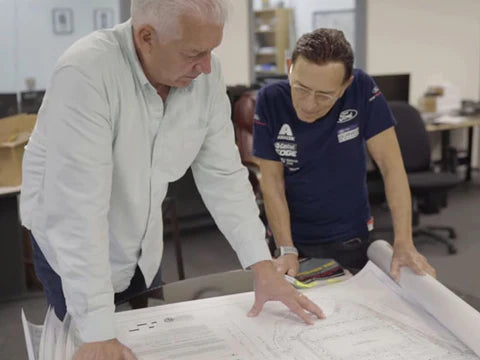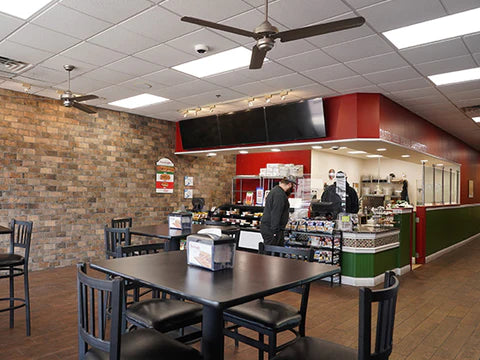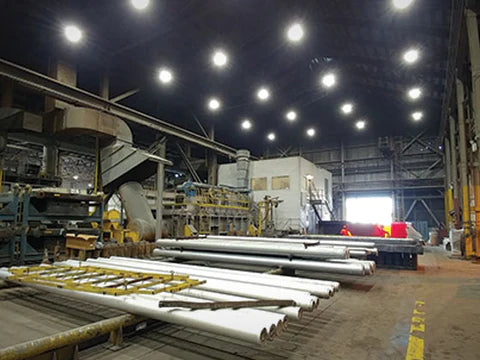5 Fast Facts You Need to Know About Linear LED High Bay Lights
T5HO Lighting Wasn't All It Was Cracked Up to Be
T5HO lights were heralded as the answer to energy-expensive metal halide lights; they'd save you a bundle on your electricity bill while providing the same bright light you'd become used to. Unfortunately, companies that switched out their metal halide lights for T5HO fixtures found the brightness to be oversold; the actual lamps seemed dimmer than the metal halides they replaced. It also turned out that switching to a T5 fixture meant that six bulbs instead of one would burn out and have to be replaced on a regular basis.
Fortunately, these T5HO fixtures have been around long enough that they've paid for themselves several times over, freeing companies to look at investments now that would not only provide an even greater reduction in energy costs but also minimize lamp replacements and provide truly bright light. That's where the latest developments in linear high bay LED lights come in...
You can replace your 27,000-lumen, 324 Watt 6-lamp T5 fluorescent fixture with a 30,000-lumen, 240 Watt LED fixture that's rated for an average lamp life of 50,000 hours. That's a 25% reduction on your light bill and a 70% extension on the time between lamp replacements—and you'll only have one lamp to replace instead of six.
Linear LED High Bay Lights aren't Just for Industrial Use
Linear high bay LED lighting can slash electric costs in supermarkets, cafeterias, gymnasiums and recreation centers, educational facilities, convention centers, airports and aircraft hangars, parking garages, high-ceiling offices, large loft spaces, and more.
Aisle Lighting is a Different Ball Game
Commercial warehouses, retail warehouse clubs, and big box stores have aisles of shelving that need to be well lit all the way down to ground level. Shadowed shelves slow your employees when they're picking for orders, and in retail they make your merchandise look drab. Fixtures that aren't designed for aisles waste a lot of their light across the very top shelf, where no one's looking. With aisle lighting, you're looking for a rectangular fixture with a beam angle, such as 60˚ x 90˚, that will cast light against the faces of your shelves instead of across the top.
And while you're optimizing the spread of your aisle lighting, you might as well optimize the energy efficiency and operating life as well. LED aisle lighting can extend operating life by 70% to 400% (depending on whether you're replacing fluorescent, which can last up to 30,000 hours, or metal halide, which loses about 50% of its light output after 10,000 hours).
Also, our LED aisle lights aren't limited to high bay applications, such as warehouses and warehouse clubs—they can be installed in ceilings as low as 13 feet, for smaller inventory and kitting rooms and retail stores.
Shape Matters
Circular fixtures cast circular beams; rectangular fixtures cast rectangular beams. You'll want to keep that in mind when you work out the lighting design for your space. Round LED high bays certainly have their place, but if you're going to illuminate a long workbenches or a production line, you may get more efficient results from a rectangular linear high bay—maybe. This is where a DIALux simulation can really help out.
Our team at ELEDLights can provide a free visualizations of lighting using your room dimensions, ceiling height, and work spaces that give you a real feel for how different beam angles and shapes will work with your space. Just give us a call at 215.355.7200 or email lights@eledlights.com.
There Are a Lot of Cheap LED High Bays Out There
You may have noticed that with LED lighting, a light from one supplier often looks just like a light from another. This is due to what are called "public molds" that are used for the lights' housing. Manufacturers in China can access public molds for significantly less cost than it takes to develop their own private molds. Lights made using public molds, therefore, can be sold more cheaply. Saving money is good, right?
It is—but where else is the manufacturing cutting costs? "Deals" can be "duds" when a supplier saves money on more than just the light's appearance. For instance, a manufacturer may use fewer or less efficient LEDs. The driver may be lower quality, and/or the light may be driving at 100% capacity, which is a recipe for early failure. Assembly quality and oversight may be lacking, another recipe for early failure.
When a manufacturer cuts corners, they're also reluctant to honor their warranties. You may find yourself wasting valuable time arguing over whose fault the failure was.
Whether you're replacing an entire factory floor, distribution warehouse, big box store, office complex—or even just a small dental office—you need the project done right, right from the start, so you can forget about lighting and focus on your business. ELEDLights wants you to be able to focus on your business too. That's why we have our own engineers regularly inspecting the facilities and quality assurance processes of the manufacturers we use, as well as the lights that come off their production lines.
ELEDLights grew out of Manncorp, Inc., a company that has been providing manufacturing equipment to the electronics assembly industry for over fifty years. (Manncorp even sells LED manufacturing equipment!) When we take apart a light to look at the circuity, components, and how they were assembled, we know what we're looking at. When we walk through an assembly line and watch how things are done, we know what we're looking for.
We even involve ourselves in the packaging of the lights we sell: we want your lights to arrive in the best possible condition, every time.
If you do have a light fail or arrive damaged, you want to know you can get it replaced with a quick phone call, not a lengthy chain of frustrating back-and-forth emails, and ELEDLights gives you exactly that. We stand behind our products 100%. Just check any of the reviews under our products: we consistently provide fast, personalized customer service, and we're always just a text or phone call away.

 215.355.7200
215.355.7200




